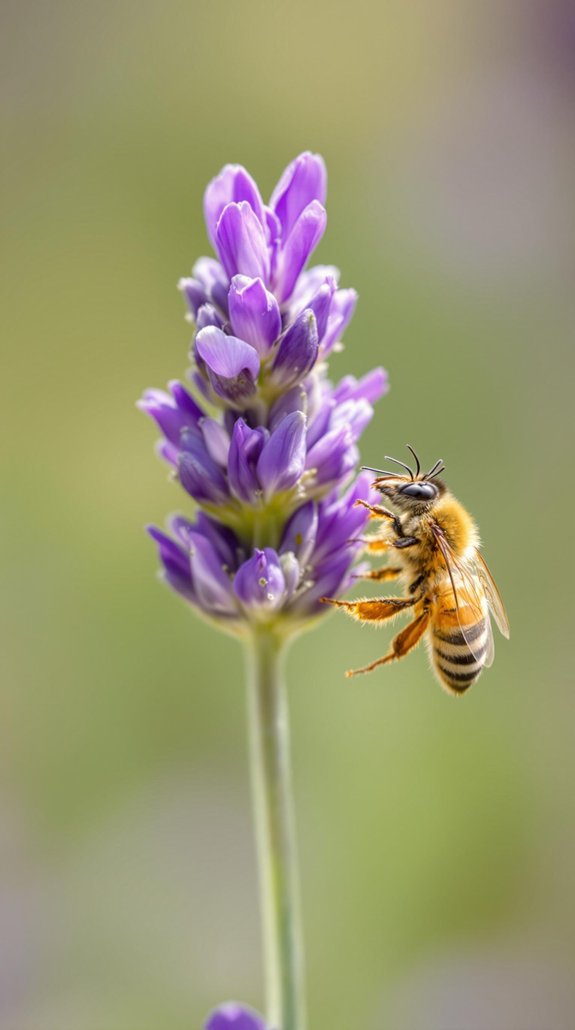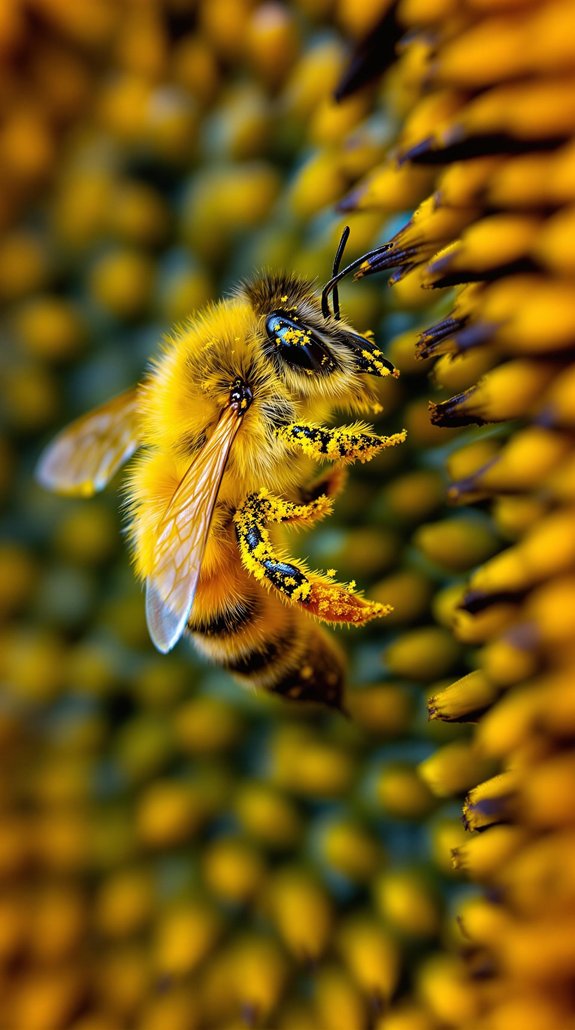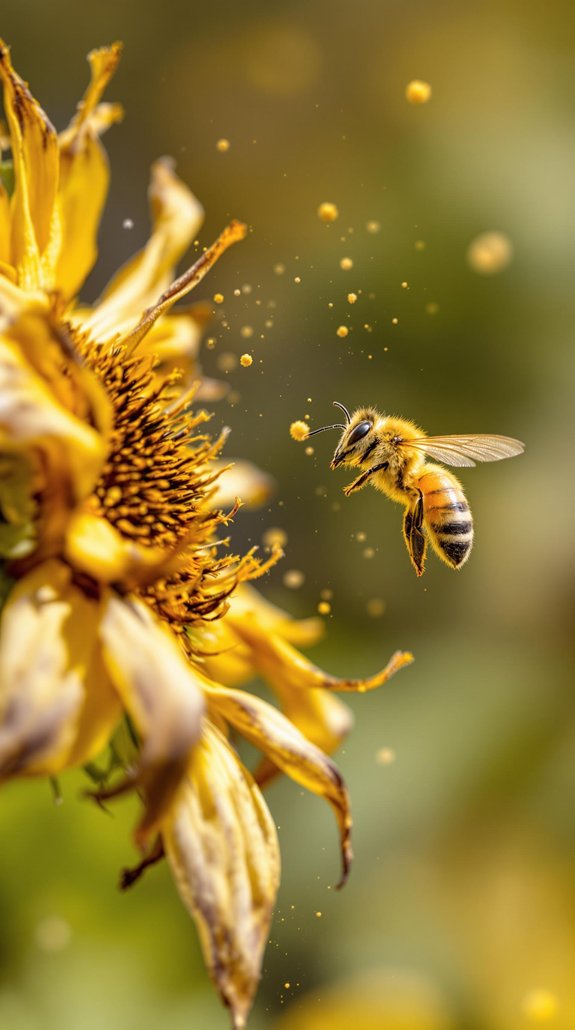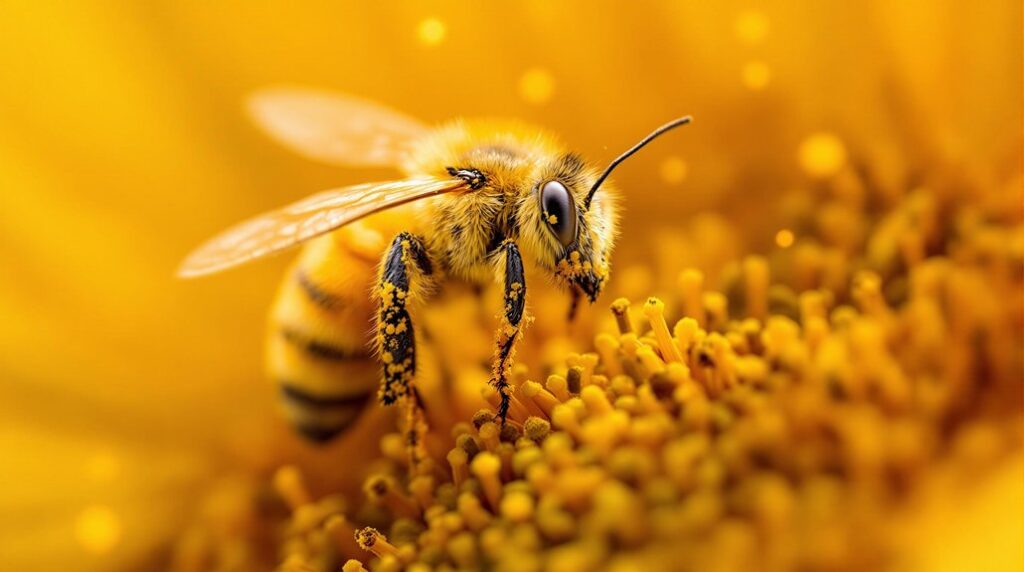When you observe bee pollination, you’re watching bees use specialized mouthparts to scrape pollen from flower anthers while electrostatic charges cause pollen to stick to their fine body hairs. They mix this pollen with nectar to form pellets stored in corbiculae on their hind legs. As they visit flowers guided by UV-reflective patterns and sweet scents, residual pollen transfers to new stigmas, enabling cross-pollination. This intricate process involves remarkable adaptations that guarantee ecosystem survival.
How Flowers Attract Their Buzzing Partners

While you might admire a flower’s beauty through human eyes, bees experience an entirely different visual world that flowers have evolved to exploit. You can’t see the UV-reflective patterns that flowers display like landing strips, but bees navigate by these invisible nectar guides—lines, dots, and bullseye patterns directing them straight to floral centers.
You’ll notice flowers showcasing blues, yellows, and purples rather than reds, since bees can’t perceive red wavelengths.
Beyond visual cues, flowers emit sweet, minty scents that you’d find pleasant but serve as long-distance bee attractants. They’ll even generate electrostatic charges on their petals, enhancing pollen adhesion when bees land.
Temperature differences between flower parts guide heat-seeking bees, while flowers time their nectar production to match peak bee activity hours. Female bees possess specialized structures that allow them to efficiently collect and transport pollen back to their colonies.
The Step-by-Step Journey of Pollen Transfer
Once a bee lands on a flower, the real work of pollen transfer begins through a carefully orchestrated process that unfolds in distinct stages. You’ll observe the bee using specialized mouthparts to scrape pollen grains directly from flower anthers.
As it moves, electrostatic attraction causes pollen to accumulate on the bee’s body hairs. The bee then regurgitates nectar to mix with collected pollen particles, forming cohesive, viscoelastic pellets.
Electrostatic forces draw pollen onto specialized bee hairs, where regurgitated nectar transforms loose grains into compact, transportable pellets.
These pellets get packed into corbiculae—specialized pollen baskets on the bee’s hind legs. A single honey bee can carry up to 35% of its body weight in pollen during these foraging trips.
During subsequent flower visits, residual pollen on the bee’s body naturally brushes onto new flower stigmas, enabling cross-pollination. This passive transfer occurs while the bee focuses on nectar collection, ensuring pollen travels from stamen to stigma for successful fertilization between plants.
Remarkable Adaptations That Make Bees Perfect Pollinators

Through millions of years of evolution, bees have developed an extraordinary suite of physical and behavioral adaptations that make them nature’s most efficient pollinators.
You’ll notice their fine body hairs trap pollen particles during flower visits, while specialized proboscis lengths reaching 13mm access deep nectar recesses. Their compound eyes detect ultraviolet nectar guides invisible to you, and corbicula pollen baskets on hind legs store massive pollen payloads.
You’d be amazed by their behavioral strategies too. Bees practice floral constancy, focusing on specific flower species during trips. They perform buzz pollination at 350Hz to liberate pollen from plants like tomatoes.
Their optimized foraging routes minimize energy waste, while colony labor division guarantees older bees handle pollination duties most effectively. Worker bees communicate valuable foraging locations through their intricate waggle dance behavior.
Floral Design Features That Maximize Pollination Success
Countless flowers have evolved sophisticated architectural features that work like precision-engineered landing strips, guiding pollinators exactly where they need to go while maximizing pollen transfer efficiency.
You’ll notice how petals form strategic landing platforms that perfectly accommodate a bee’s size and weight. These flowers use zygomorphic symmetry—think snapdragons and orchids—to direct bees’ movement toward reproductive structures.
The floral tubes you see have evolved specific lengths matching bee mouthparts, while nectar guides create visual pathways using color patterns.
Strategic nectar placement near anthers and stigma guarantees contact during feeding. Many flowers prevent self-pollination through structural barriers and timing mechanisms, forcing bees to visit multiple plants. Some flowers even employ deceptive strategies like mimicking female insects to attract male pollinators without offering any nectar reward.
This co-evolutionary dance between flower architecture and bee anatomy maximizes successful pollination while rewarding bees with nectar.
Environmental Threats Disrupting Natural Pollination Cycles

However, these remarkable evolutionary partnerships between flowers and pollinators now face unprecedented disruption from multiple environmental threats.
You’re witnessing a 50% decline in North American bumblebee populations since 1974, driven primarily by habitat destruction and fragmentation. Climate change compounds these problems through phenological mismatches—plants bloom earlier than pollinators emerge, breaking synchronized relationships developed over millennia.
Neonicotinoid pesticides reduce colony growth and impair navigation abilities, while sublethal doses weaken immune systems. This creates vulnerability to pathogens like Varroa mites and viral diseases that devastate bee colonies.
Invasive species further destabilize pollination networks by outcompeting native pollinators and introducing new pathogens. Garlic mustard produces chemicals that have toxic effects on butterfly eggs, demonstrating how invasive plants can directly harm reproductive success in native pollinator species. Combined with intensive agriculture and urbanization, these threats isolate pollinator communities and eliminate critical nesting sites and flowering plants essential for survival.
Economic and Ecological Impact of Bee-Mediated Reproduction
When you examine the economic footprint of bee-mediated reproduction, the numbers reveal a staggering dependency that extends far beyond individual farms or regions.
You’re looking at $34 billion in total economic value from pollinators annually, with honey bees alone contributing $15 billion to U.S. agriculture. This isn’t just about money—you’re witnessing the foundation of food security itself.
You’ll find that 87 of the top 115 global food crops require animal pollination, representing 35% of worldwide production.
When you consider that 90+ commercial crops in North America depend on honey bees, you’re seeing an intricate web where ecological health directly translates to economic stability.
However, you’re also facing concentrated risks: 20% of U.S. counties produce 80% of pollinator-dependent output, creating vulnerable agricultural hubs. The crisis deepens when one third of managed honeybee colonies die each winter across the United States.
References
- https://www.perfectbee.com/learn-about-bees/the-science-of-bees/exploring-the-process-of-pollination
- https://plantura.garden/uk/insects/bees/bee-pollination
- https://bees.techno-science.ca/english/bees/pollination/default.php
- https://www.canr.msu.edu/nativeplants/pollination
- https://wildearthlab.com/2023/05/03/pollination-steps/
- https://www.fs.usda.gov/wildflowers/pollinators/Plant_Strategies/visualcues.shtml
- https://ohioline.osu.edu/factsheet/ENT-47
- https://piedmontmastergardeners.org/article/how-flowering-plants-attract-pollinators/
- https://www.virginfarms.com/flower-fact-friday-what-attracts-pollinators-to-flowers/
- https://www.edntech.com/blogs/news/the-perfect-relationship-flowers-bees

Erzsebet Frey (Eli Frey) is an ecologist and online entrepreneur with a Master of Science in Ecology from the University of Belgrade. Originally from Serbia, she has lived in Sri Lanka since 2017. Eli has worked internationally in countries like Oman, Brazil, Germany, and Sri Lanka. In 2018, she expanded into SEO and blogging, completing courses from UC Davis and Edinburgh. Eli has founded multiple websites focused on biology, ecology, environmental science, sustainable and simple living, and outdoor activities. She enjoys creating nature and simple living videos on YouTube and participates in speleology, diving, and hiking.
🌿 Explore the Wild Side!
Discover eBooks, guides, templates and stylish wildlife-themed T-shirts, notebooks, scrunchies, bandanas, and tote bags. Perfect for nature lovers and wildlife enthusiasts!
Visit My Shop →
